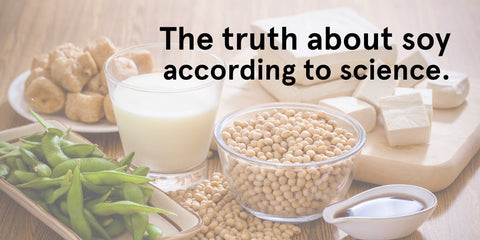Photo by Kelly Sikkema from Unsplash.com
Creamy. Dreamy. Delightful.
Protein shakes are efficient, sippable snacks that can spark muscle recovery, feed your body nourishing calories, and supply a number of vitamins and minerals.
But not all protein shakes are blended equally!
The source of protein, the quality of protein, and additions such as healthy fats can make for a vitalizing, well-rounded shake, or one that’s simply subpar. Today, we’re discussing what exactly makes a protein shake healthy.
Protein and its Numerous Forms
Without added protein, you’re only drinking a milkshake or frozen fruit smoothie of sorts. The myriad benefits of protein are what make protein shakes a powerful dietary supplement and booster to your daily food and calorie intake.
The Sheer Importance of Protein
Protein is critical for life. It’s a building block of everything you are.
In the absence of protein, your body would refuse to do anything and descend into a meltdown worse than a tuckered-out toddler. Astonishingly, between your organs, muscles, tissues, bones, skin, and hair, there are over 10,000 types of protein present in your bodily makeup.
Protein is like that one handy friend you have who can seemingly fix or put back together anything. Your body isn’t merely composed of proteins but demands and devours protein too.
Protein is used in essential processes like building and repairing muscles, strengthening bones, boosting the immune system, diminishing food cravings, supporting heart health, and healing inflammation and injuries. Trust us when we say that protein is more important for your body than water is for house plants. Have you checked on those lately?
There’s numerous forms of protein powder to choose from on the market, such as:
- Whey protein
- Soy protein
- Milk protein
- Egg protein
- Brown rice protein
- Pea protein
- Hemp protein
Each form delivers distinct benefits and affects your health and fitness goals differently. We’ve gathered critical information about three of the most popular forms of protein. Before we dig our plastic scoops into these different tubs, it’s first beneficial to understand the fundamental differences between protein isolate and protein concentrate.
Why Isolate Outmatches Concentrate
Remember when we declared that not all protein shakes are blended equally? There’s layers to that declaration! When considering a protein shake, be conscious of whether it was made with protein isolate or protein concentrate, the former being the preferred form of protein.
Here’s a crash course.
Protein concentrate is less processed, and because it’s less processed, it’s cheaper. But the context of the word “processed” is significant here.
A common health assumption is that eating less processed foods is generally healthier across the board. And when it comes to vegetables, meats, produce, and grains, this is true! Yet, regarding protein powders, it’s the opposite.
Because protein concentrate is less processed than protein isolate, other components like carbs or fats haven’t been filtered out of it as effectively. Thus, protein concentrate delivers less protein per scoop. In other words, it’s less efficient.
Though it’s notably pricier, protein isolate is the gold standard of protein. It passes through more processing to further remove the other components present and ultimately isolates the protein itself. Hence, the name protein isolate.
At Soylent, we love soy protein isolate, and we gladly fork over the extra cost for it. It’s the reason we’re able to pack 20 grams of plant-based protein into 14 ounces of liquid in our Soylent Complete Meal Drinks.
Whey Protein
You’ve probably read “Whey Protein” in bold, macho font plastered across shiny containers in your local grocery or supplement shop.
Whey protein is a mainstay of the exercise and fitness industry as it contains all the essential amino acids, boosts energy, and is said to even reduce stress levels. However, for some this animal-based protein is falling out of vogue because it is less sustainable than soy, its plant-based counterpart.
Whey, a by-product of the cheese-making process, comes from dairy, specifically cow’s milk. Consuming whey isolate and concentrate is beneficial following an intense workout as they immediately begin feeding and repairing strained muscles.
Soy Protein
While some athletes obsess over animal proteins such as whey, milk, and egg, plant-based proteins have been scientifically proven to pack an equal punch and the same nutrition benefits of its animal based counterparts - without all the negative impacts to the environment.
Soy is the pinnacle of plant-based proteins and our top pick for non-dairy protein shakes. An all-around, nutritionally complete protein with a multitude of benefits, Soy has been proven to reduce blood pressure and even ease the symptoms of menopause for some women.
Soy is derived from soybeans, a popular and widely used legume. This is the same loved bean that creates some of your favorite foods, including tofu, tempeh, and edamame. Yet, unlike other legumes, soy offers the most plentiful amino acid profile, making it a complete protein. A complete protein is one that contains all 9 of the essential amino acids our bodies can't produce themselves. There are no other sustainable and available plant-based proteins that have this same profile.
To create soy protein, manufacturers strip away the hulls and most of the fat from soybeans. The remaining portion of the soybean can then be ground down and turned into soy protein isolate.
Soy foods are cholesterol-free and low in saturated fat, which defines soy as a healthy protein that fuels your body without adding any health-related risks. Like dairy proteins, soy ignites muscle recovery and repair and fills you up too.
Pea Protein
Did you eat your peas as a kid or yell “yuck!” at the top of your lungs? Thanks to modern food processing techniques, you can get your share of peas without spooning them from a cold bowl while your mother hawks over you till the last bite.
Pea protein has earned recognition as a heavy hitter in the plant-based corner of the protein market. Peas are a lean, slow-burning source of protein that offer fiber, iron, vitamin D, vitamin E, vitamin K, and vitamin A. However, unlike soy, pea protein is not a complete protein, and lacks the correct volumes of all amino acids, and thus has to be mixed with other protein sources in order to provide all essential amino acids, making it less sustainable.
Pea protein, unsurprisingly, is extracted from peas that are crushed up into a smooth powder and processed to remove starch and fiber from the mix. While you might not be fond of the flavor of peas from your youth, pea protein still has some of the same obstacles because there isn’t as much flavor masking technology for this protein source. Therefore, many people looking for plant-based protein sources choose soy because it tastes so much better. In addition, there is a rising intolerance for pea protein so please make sure you do not have this allergy before using this protein.
Healthy Protein Shake Recipe Musts
The beauty of blenders is that you can toss any number of ingredients into them and turn those ingredients into something creamy and smooth. Blended shakes also appear to magically mask flavors that taste unsavory on their own. Here are a few healthy additions to elevate your protein shakes.
Healthy Fats
Fat, like protein, is an essential macronutrient for your body. Healthy fats are abundant in foods like avocados, oils, nuts, nut butters, and fish. Consciously adding fats to your protein shakes will help your body store energy, lower your risk of heart disease, and lower high blood pressure. Fat and protein are synergistic and support both health and recovery in combination, so shakes that include both fat and protein can provide muscle support and energy for your body while it recovers and repairs.
Consider freezing avocado chunks to blend up with your shakes. Avocados are loaded with healthy fats and add a thick, creamy texture to your shakes.
In our Complete Meal Drinks, we add healthy fats like Canola oil, Omega-3, and Omega-6 to support heart health.
Frozen Fruit
A healthy diet isn’t complete without fruit consumption and the nutrients that they contain. The USDA suggests adults consume two servings of fruit per day. So why not knock one or both servings out in your protein shake?
Strawberries, blueberries, raspberries, and bananas will all work to naturally sweeten a protein shake while feeding you the essential vitamins and minerals your body needs to function.
Chia Seeds
These puny, black, nutrient-dense seeds carry a whopping supply of fiber and antioxidants. Chia seeds have risen in popularity and become a beloved superfood addition to smoothies and shakes alike. The four antioxidants present in chia seeds help fight free radicals in your body and reduce signs of inflammation.
Shake It Up
That’s your overview of the importance of protein consumption, the breakdown of popular types of proteins, the difference between protein isolate and concentrate, and a few healthy additions to elevate the health benefits of your protein shakes.
Get blending or shaking, and stay healthy at every sip friends!






